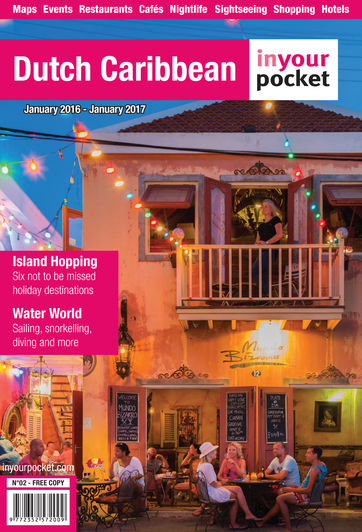2500 BC - First inhabitants arrive
The first people set foot on Curacao. They were probably Indians from South America’s northern shores. These nomadic tribes were skilled fishermen and hunter/gatherers. The first round-shaped houses were built around 500 BC.
1499 - First Conquistadors arrive
No one can say for certain which European ‘discovered’ Curacao. Was it Amerigo Vespucci from Florence or the Spanish conquistador Alonso de Ojeda? A letter dating from 1505 states that some of Vespucci's men were on Curacao and bumped into ‘giant Indians’, which was the reason the island was named Islas de los Gigantes.
1634 - Dutch presence
On April 6, 1634 it was decided that the Dutch would attack the Spanish garrison on Curacao to gain control of the lucrative salt market. The strategic harbour at present-day Willemstad was another reason to conquer the island. Salt was needed to preserve herring, two of the world’s most coveted products at that time. On August 21 of that year the Dutch commander Johannes van Walbeeck attacked with only 200 men and quickly gained control of the whole island. The surviving Spanish soldiers and the native Indians were brought to the South American mainland. Only 75 Arawak Indians were allowed to stay in the village of Ascencion.
1636 - Fort Amsterdam
After defeating the Spanish the Dutch began building the impressive Fort Amsterdam. It was a solid defence system as well as the headquarters of the Dutch Company (WIC), which financed the war. In total, eight forts were built, but none were as important or large as this one. Today the government of Curacao resides here.
1639 - Slavery is introduced
After beating the Portuguese at Fort Elmina (Ghana) in 1636, the Dutch became one of the leading suppliers of slaves in the entire world. For many slaves the abominable journey across the ocean ended at Curacao. The Spanish, Portuguese, British, French, Danish and American plantation holders needed ever more slaves and were more than happy to buy these unfortunate souls. In total, around 100,000 slaves were sold before the revolting practise was abolished.
1651 - The first Jews
Samuel Cohen was the first Jew to arrive on Curacao and from 1651 onwards more and more Jewish families from Amsterdam settled on the Caribbean island. Together they formed the Mikve Israel-Emmanuel community, which worships at the oldest functioning synagogue in North and South America. The Jewish community thrived and the native Papiamento language was enriched with Hebrew words.
1713 - Pesos & Ransom
Jacques Cassard was a famous 18th-century French sailor who made heaps of money for his country by attacking English, Portuguese and Dutch possessions in the Caribbean. Between 1712 and 1714 he attacked the Dutch islands several times. When he received 115,000 pesos to stop his attack on Willemstad, he left in search of other islands to raid.
1795 - Tula & The Revolt
In the early morning of August 17, 1795, 40 brave slaves began something what would later be known as The Revolt. They refused to go to work at the Knip plantation on the far west side of the island. Tula was appointed as their leader and an ‘army’ of slaves moved all the way to Willemstad to ask for their freedom from their Dutch masters. A month later Tula was captured, brutally tortured and killed with 29 other slaves. It would take another 68 years before these ‘seeds of freedom’ would finally take root when slavery was finally abolished by the Dutch.
1863 - Slavery abolished
Although the Dutch signed a proclamation abolishing slavery as early as 1841, it took another 22 years before it was finally implemented. Plantation holders and other ‘legal owners of slaves’ were compensated by the state and received 330 guilders for each slave. To make things even worse, slaves were forced to work the next 10 years at the same plantations from which they were ‘freed’. In total around 550,000 Africans were kidnapped by the Dutch and forcibly moved to the Dutch Caribbean.
1888 - Swinging Old Lady
One of the greatest landmarks of Curacao is the Koningin Emmabridge. It was opened in 1888 and connects the two major areas (Punda and Otrobanda) of Willemstad. This 168m-long bridge is the only 'swinging' wooden bridge in the world. Until 1934 a toll had to be paid to cross the Annabaai, unless of course you were barefoot, a sign that you belonged to the lower poverty-stricken class of society. Today 15,000 people cross the most photographed bridge in the Caribbean every day.
1969 - Trinta di Mei
On May 30, 1969 a strike began at the Shell oil refinery and was later known as Trinta di Mei. The strikers not only demanded higher wages, but also racial equality among workers. The Dutch government responded with excessive force and its leader, Wilson ‘Papa’ Godet, and two of his men were killed on the spot leading to an island-wide revolt. Only after the Dutch flew in marines from the Netherlands was order was restored on Curacao. The brave actions of Papa Godet were later seen as a turning point in Dutch-Afro-Caribbean relations.
1997 - Old town makes the UNESCO list
In 1997 Willemstad was added to the UNESCO World Heritage list with the following recommendation: “The Historic Area of Willemstad is a European colonial ensemble in the Caribbean of outstanding value and integrity, which illustrates the organic growth of a multicultural community over three centuries and preserves to a high degree significant elements of the many strands that came together to create it.”




